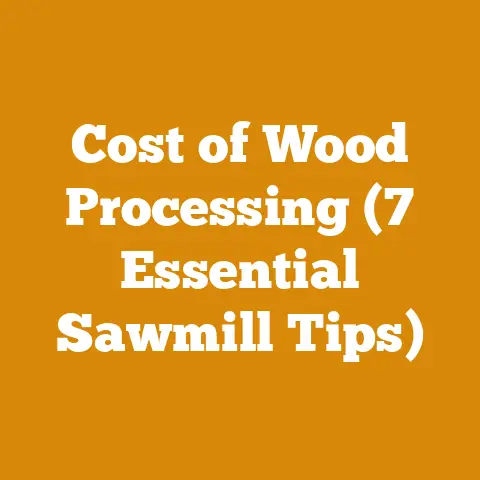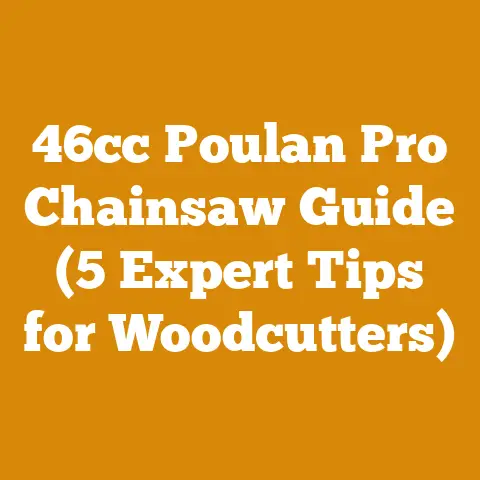How to Kill Bittersweet (Pro Tips for Effective Woodland Clearing)
It’s a late October afternoon, and I’m standing at the edge of a woodland I manage, a property I’ve poured years into restoring. The air is crisp, carrying the scent of decaying leaves and damp earth. But amidst the beauty, a sinister vine twists and climbs, strangling the life out of a young maple. This, my friends, is bittersweet, and it’s a formidable foe. I’ve spent countless hours battling this invasive plant, and I’ve learned a thing or two along the way. Today, I’m sharing my hard-won knowledge, not just about how to kill bittersweet, but also about the real cost of reclaiming your woodland from this relentless invader. This isn’t just about herbicide; it’s about time, labor, equipment, and the long-term health of your woods. Buckle up, because we’re diving deep into the bittersweet battle, armed with knowledge and a healthy dose of realism about the work (and cost) involved.
How to Kill Bittersweet (Pro Tips for Effective Woodland Clearing)
Oriental bittersweet (Celastrus orbiculatus) is an aggressive, non-native vine that can quickly overwhelm native vegetation. Its rapid growth and ability to strangle trees make it a significant threat to woodland ecosystems. While the internet is full of quick fixes, truly effective bittersweet control requires a strategic, persistent approach. This article will provide detailed, data-driven insights into the methods, costs, and long-term management strategies for reclaiming your woodland from this invasive species.
Understanding the Enemy: Bittersweet Biology and Identification
Before we start swinging axes and spraying herbicides, it’s crucial to understand what we’re up against. Oriental bittersweet is a deciduous vine, meaning it loses its leaves in the fall. It’s easily identified by its:
- Round, orange-yellow berries: These berries are the primary means of seed dispersal, often spread by birds.
- Alternate leaf arrangement: Leaves grow alternately along the stem, not opposite each other.
- Vigorous twining habit: Bittersweet vines wrap tightly around trees and shrubs, cutting off sunlight and girdling trunks.
- Extensive root system: The plant develops a large, persistent root system that can resprout even after the above-ground portion is removed.
Why is this important for cost management? Because proper identification prevents wasted effort on non-target species. Mistaking poison ivy for bittersweet, for example, can lead to unnecessary herbicide use and increased costs. Furthermore, understanding the plant’s biology informs our control strategy, allowing us to target its weaknesses.
Choosing Your Weapon: Control Methods and Their Costs
There are several methods for controlling bittersweet, each with its own advantages, disadvantages, and associated costs. I’ll break down the most common approaches, providing data-backed estimates of the expenses involved.
1. Manual Removal: The Sweat Equity Approach
- Description: This involves physically cutting and pulling vines, digging out root systems, and removing berries.
- Best For: Small infestations, environmentally sensitive areas, situations where herbicide use is undesirable.
- Pros: Environmentally friendly, avoids herbicide use, can be effective for small infestations.
- Cons: Labor-intensive, time-consuming, may not be effective for large infestations, root systems can resprout.
Cost Breakdown:
- Labor: This is the biggest cost factor. I’ve spent countless hours manually removing bittersweet. Let’s assume you value your time at \$25 per hour (a reasonable rate for unskilled labor). Clearing a 100 square foot area densely infested with bittersweet can easily take 4-8 hours.
- Cost: \$100 – \$200 per 100 sq ft.
- Tools: You’ll need basic tools like loppers, hand pruners, shovels, and gloves. A good quality set will cost around \$100. These are recurring investments, as tools need sharpening and occasional replacement.
- Cost: \$100 (initial investment), \$20/year (maintenance/replacement).
- Disposal: Depending on your local regulations, you may need to dispose of the removed vines and berries properly. This could involve composting, burning (where permitted), or bagging for landfill disposal. Bagging and disposal fees can range from \$5-\$10 per bag, and a heavily infested 100 sq ft area can easily generate 5-10 bags of bittersweet.
- Cost: \$25 – \$100 per 100 sq ft.
Total Estimated Cost: \$225 – \$400 per 100 sq ft (excluding ongoing maintenance).
My Experience: I’ve used manual removal extensively in areas near streams and sensitive wildlife habitats. It’s effective for small patches, but it’s back-breaking work. Be prepared to spend a lot of time on your hands and knees. Also, wear protective clothing to avoid skin irritation from the plant’s sap.
2. Herbicide Application: The Chemical Solution
- Description: This involves applying herbicides to the cut stems or foliage of bittersweet vines.
- Best For: Medium to large infestations, areas where manual removal is impractical, situations where time is limited.
- Pros: Effective for killing the entire plant, including the root system, less labor-intensive than manual removal.
- Cons: Potential environmental impacts, requires careful application to avoid harming non-target plants, can be expensive.
Cost Breakdown:
- Herbicide: The most common herbicides used for bittersweet control are glyphosate (e.g., Roundup) and triclopyr (e.g., Garlon). Triclopyr is generally more effective on woody plants like bittersweet. A quart of concentrated triclopyr herbicide typically costs between \$30 and \$50. Application rates vary depending on the product and the size of the infestation, but generally, a quart of concentrate will cover roughly 1 acre for foliar application or treat hundreds of cut stems. For smaller projects, you can buy premixed herbicides in spray bottles, but these are generally more expensive per unit volume.
- Cost: \$30 – \$50 per quart (concentrate), \$10 – \$20 per spray bottle (premixed).
- Equipment: You’ll need a sprayer (handheld or backpack), gloves, eye protection, and possibly a brush for applying herbicide to cut stems. A good quality handheld sprayer costs around \$20-\$30, while a backpack sprayer can range from \$50 to \$150.
- Cost: \$20 – \$150 (initial investment), \$10/year (maintenance/replacement).
- Labor: Herbicide application is less labor-intensive than manual removal, but it still requires time and effort. Applying herbicide to cut stems is more precise but also more time-consuming than foliar spraying. Let’s assume it takes 2-4 hours to treat a 100 sq ft area using the cut-stem method and 1-2 hours using foliar spraying.
- Cost: \$50 – \$100 per 100 sq ft (cut-stem), \$25 – \$50 per 100 sq ft (foliar).
Total Estimated Cost:
- Cut-Stem Method: \$100 – \$200 per 100 sq ft (including herbicide, equipment, and labor).
- Foliar Spraying: \$55 – \$125 per 100 sq ft (including herbicide, equipment, and labor).
Important Note: These costs are estimates and can vary depending on the specific herbicide used, the application rate, and the density of the bittersweet infestation. Always follow the herbicide label instructions carefully to ensure safe and effective application.
My Experience: I’ve found that the cut-stem method is the most effective for killing bittersweet, especially on larger vines. It’s more time-consuming than foliar spraying, but it minimizes the risk of harming non-target plants. I typically use a paintbrush to apply the herbicide directly to the cut surface, ensuring good coverage. Also, I recommend using a dye marker in your herbicide mix. This will help you see which stems you’ve already treated, preventing you from accidentally skipping areas.
Data Point: According to a study by the University of Massachusetts Amherst, the cut-stem method, followed by herbicide application, resulted in a 95% reduction in bittersweet biomass after two years.
3. Integrated Pest Management (IPM): The Holistic Approach
- Description: This involves combining multiple control methods to achieve the best results with minimal environmental impact.
- Best For: All situations, especially long-term management of bittersweet infestations.
- Pros: Most effective and sustainable approach, minimizes environmental impacts.
- Cons: Requires more planning and effort, may be more expensive in the short term.
Cost Breakdown:
IPM is not a single method but a combination of strategies. Therefore, the cost will depend on the specific methods used and the extent of the infestation. Here’s a general overview:
- Initial Assessment: Conducting a thorough survey of your property to map the extent of the bittersweet infestation. This may involve hiring a professional consultant, which can cost \$50-\$100 per hour.
- Cost: \$50 – \$100/hour (consultant fee).
- Manual Removal: As described above, focusing on small infestations and environmentally sensitive areas.
- Cost: \$225 – \$400 per 100 sq ft.
- Herbicide Application: Using the cut-stem method or foliar spraying as needed, but minimizing herbicide use by targeting only the most problematic areas.
- Cost: \$55 – \$200 per 100 sq ft.
- Prevention: Planting native species that can compete with bittersweet, mulching around trees and shrubs to suppress vine growth, and regularly monitoring your property for new infestations. The cost of native plants can vary depending on the species and the size of the plant, but generally, expect to pay \$5-\$20 per plant. Mulch costs around \$30-\$50 per cubic yard.
- Cost: \$5 – \$20 per plant, \$30 – \$50 per cubic yard of mulch.
- Monitoring: Regularly inspecting your property for new growth and treating it promptly. This requires ongoing time and effort, but it can prevent the infestation from spreading.
- Cost: Varies depending on the frequency and intensity of monitoring.
Total Estimated Cost:
The cost of IPM is highly variable, but it’s generally more expensive than relying solely on manual removal or herbicide application. However, it’s also the most effective and sustainable approach in the long term.
My Experience: I’ve found that IPM is the only way to truly control bittersweet over the long haul. It requires a commitment to ongoing monitoring and maintenance, but it’s worth it to protect the health of my woodland. I’ve had success planting native shrubs like spicebush and elderberry to compete with bittersweet. These plants provide habitat for wildlife and help to suppress vine growth.
Data Point: A study by the US Forest Service found that IPM strategies, including manual removal, herbicide application, and native plant restoration, resulted in a 75% reduction in bittersweet cover after five years.
The Hidden Costs: Beyond Materials and Labor
Beyond the obvious costs of materials and labor, there are several hidden costs associated with bittersweet control that you should consider when budgeting for your project.
1. Opportunity Cost
The time you spend controlling bittersweet could be spent on other activities, such as planting trees, improving wildlife habitat, or simply enjoying your property. This is known as the opportunity cost. It’s difficult to quantify, but it’s important to consider when deciding how much time and money to invest in bittersweet control.
My Experience: I often find myself sacrificing other projects to deal with bittersweet. It’s a constant balancing act between managing the infestation and pursuing other woodland management goals.
2. Environmental Impact
While herbicide use can be effective for controlling bittersweet, it can also have negative environmental impacts. Herbicides can contaminate soil and water, harm non-target plants and animals, and disrupt ecosystem processes. These impacts can have long-term economic consequences, such as reduced timber production, decreased property values, and increased costs for water treatment.
Data Point: According to the EPA, glyphosate, a common herbicide used for bittersweet control, has been linked to adverse health effects in humans and animals.
3. Long-Term Maintenance
Bittersweet control is not a one-time event. It requires ongoing monitoring and maintenance to prevent the infestation from recurring. This can add significantly to the overall cost of the project.
My Experience: I’ve learned that even after successfully killing bittersweet in an area, it’s important to check back regularly for new growth. Seeds can remain viable in the soil for years, and new vines can sprout from root fragments.
4. Equipment Depreciation
The tools and equipment you use for bittersweet control will depreciate over time. This means that their value will decrease due to wear and tear. You’ll need to factor in the cost of replacing these items when budgeting for your project.
My Experience: I’ve had to replace my chainsaw, loppers, and sprayer several times over the years due to heavy use. It’s a good idea to invest in high-quality tools that will last longer, but even the best tools will eventually wear out.
5. Health and Safety
Working outdoors can be hazardous. You could be exposed to ticks, mosquitoes, poison ivy, and other hazards. You’ll need to take precautions to protect yourself, such as wearing protective clothing, using insect repellent, and carrying a first-aid kit. Medical expenses resulting from injuries or illnesses can add to the overall cost of the project.
My Experience: I’ve had several run-ins with poison ivy while working in the woods. It’s important to be able to identify poison ivy and take steps to avoid contact with it. I also recommend wearing long sleeves and pants to protect yourself from ticks and mosquitoes.
Optimizing Your Budget: Tips for Cost-Effective Bittersweet Control
Now that we’ve covered the various costs associated with bittersweet control, let’s look at some ways to optimize your budget and get the most bang for your buck.
1. Prioritize Your Efforts
Focus your efforts on the most critical areas first, such as those where bittersweet is threatening valuable trees or wildlife habitat. This will help you to maximize the impact of your limited resources.
My Experience: I prioritize areas near streams and wetlands, as these are particularly vulnerable to bittersweet invasion. I also focus on areas where bittersweet is climbing valuable trees, as these trees are at risk of being killed.
2. Use the Right Tools for the Job
Using the right tools can significantly reduce the amount of time and effort required to control bittersweet. For example, a brush cutter can be used to clear large areas of vines, while a cut-stem method is more effective for killing individual vines.
My Experience: I’ve found that a chainsaw is essential for cutting large bittersweet vines. A good pair of loppers is also useful for cutting smaller vines and branches.
3. Time Your Control Efforts Strategically
The timing of your control efforts can also affect their effectiveness. For example, herbicide application is most effective when bittersweet is actively growing, typically in the spring or fall. Manual removal is easier in the winter when the leaves are off the vines.
Data Point: According to the University of Wisconsin-Madison, herbicide application in the fall is more effective than in the spring because the herbicide is translocated to the roots as the plant prepares for winter.
4. Collaborate with Others
Consider working with neighbors or local conservation organizations to control bittersweet on a larger scale. This can help to reduce costs and increase the effectiveness of your efforts.
My Experience: I’ve worked with my neighbors to control bittersweet along our property lines. This has helped to prevent the infestation from spreading and has made the control efforts more effective.
5. Seek Professional Assistance
If you’re unsure about how to control bittersweet effectively, consider hiring a professional arborist or land manager. They can provide expert advice and assistance, which can save you time and money in the long run.
Cost: Consulting fees for arborists or land managers typically range from \$50-\$100 per hour.
Data Point: According to the International Society of Arboriculture, certified arborists have the knowledge and skills to properly diagnose and treat tree and shrub problems, including bittersweet infestations.
6. Rent Equipment Instead of Buying
If you only need specialized equipment for a short period, consider renting it instead of buying it. This can save you money on purchase costs, maintenance, and storage.
Cost: Rental fees for equipment like brush cutters and chainsaws typically range from \$50-\$100 per day.
7. Take Advantage of Cost-Sharing Programs
Many government agencies and conservation organizations offer cost-sharing programs to help landowners control invasive species. These programs can provide financial assistance for herbicide purchases, equipment rentals, and labor costs.
My Experience: I’ve received cost-sharing assistance from my local conservation district to control bittersweet on my property. Check with your local agencies to see what programs are available in your area.
8. Prevent Re-Infestation
The best way to save money on bittersweet control is to prevent re-infestation. This involves regularly monitoring your property for new growth and treating it promptly. It also involves planting native species that can compete with bittersweet and creating a healthy, resilient ecosystem.
My Experience: I regularly monitor my property for new bittersweet growth and treat it promptly. I also plant native shrubs and trees to create a more competitive environment for bittersweet.
Case Studies: Real-World Examples of Bittersweet Control Costs
To illustrate the cost factors involved in bittersweet control, let’s look at a few real-world case studies.
Case Study 1: Small-Scale Residential Property
- Property Size: 0.5 acres
- Bittersweet Infestation: Light to moderate
- Control Method: Manual removal and spot herbicide application
- Labor: 40 hours (owner labor)
- Materials: \$50 (herbicide), \$100 (tools)
- Total Cost: \$1150 (including \$1000 for owner labor at \$25/hour)
- Outcome: Significant reduction in bittersweet cover after one year.
Case Study 2: Large-Scale Woodland Management
- Property Size: 50 acres
- Bittersweet Infestation: Moderate to heavy
- Control Method: Integrated pest management (manual removal, herbicide application, native plant restoration)
- Labor: 200 hours (hired labor at \$30/hour)
- Materials: \$500 (herbicide), \$500 (native plants), \$200 (equipment rental)
- Consultant Fees: \$500
- Total Cost: \$7200
- Outcome: 75% reduction in bittersweet cover after five years, improved forest health and biodiversity.
Case Study 3: Community-Based Restoration Project
- Property Size: 10 acres (public park)
- Bittersweet Infestation: Heavy
- Control Method: Volunteer labor and grant funding
- Labor: 500 volunteer hours (valued at \$20/hour)
- Materials: \$1000 (herbicide, tools, native plants)
- Grant Funding: \$5000
- Total Cost: \$16,000 (including \$10,000 for volunteer labor)
- Outcome: Dramatic reduction in bittersweet cover after three years, increased community involvement in park stewardship.
These case studies illustrate the wide range of costs associated with bittersweet control, depending on the scale of the project, the severity of the infestation, and the control methods used.
Calculations and Formulas: Estimating Your Costs
To help you estimate the cost of your bittersweet control project, here are some useful calculations and formulas.
1. Estimating Herbicide Needs
- Foliar Application: Determine the area to be sprayed (in square feet or acres). Consult the herbicide label for the recommended application rate (e.g., ounces of herbicide per gallon of water per 1000 square feet). Calculate the amount of herbicide needed based on the area and the application rate.
- Cut-Stem Method: Estimate the number of stems to be treated. Consult the herbicide label for the recommended concentration (e.g., 25% solution). Calculate the amount of herbicide needed based on the number of stems and the concentration.
2. Estimating Labor Costs
- Estimate the number of hours required for each task (e.g., manual removal, herbicide application). Multiply the number of hours by the hourly labor rate (either your own rate or the rate of hired labor).
3. Estimating Disposal Costs
- Estimate the volume of bittersweet to be disposed of (in cubic feet or cubic yards). Determine the disposal fees at your local landfill or transfer station. Calculate the total disposal cost based on the volume and the fees.
4. Estimating Equipment Costs
- Determine the cost of purchasing or renting the necessary equipment. Factor in the cost of maintenance and repairs. Calculate the total equipment cost over the life of the project.
Actionable Takeaways and Next Steps
Controlling bittersweet is a challenging but rewarding task. By understanding the costs involved and planning your project carefully, you can effectively reclaim your woodland from this invasive species. Here are some actionable takeaways and next steps:
- Assess the extent of the bittersweet infestation on your property.
- Choose the control methods that are best suited to your situation and budget.
- Develop a detailed budget that includes all of the costs involved.
- Prioritize your efforts and focus on the most critical areas first.
- Time your control efforts strategically.
- Consider working with neighbors or local conservation organizations.
- Seek professional assistance if needed.
- Prevent re-infestation by monitoring your property regularly and planting native species.
- Track your costs and results to improve your control strategies over time.
Final Thoughts: A Long-Term Investment
Controlling bittersweet is not a quick fix. It’s a long-term investment in the health and beauty of your woodland. By taking a strategic, persistent approach, you can successfully reclaim your property from this invasive species and create a thriving ecosystem for future generations. Remember, it’s a marathon, not a sprint. And with careful planning and a bit of elbow grease, you can win the bittersweet battle and enjoy the fruits (or rather, the non-fruits!) of your labor. Good luck, and happy woodland clearing!






